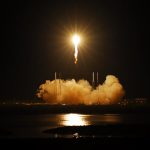By Chris Wickham and Sara Webb
LONDON/AMSTERDAM (Reuters) – The world’s biggest and most advanced radio telescope, capable of detecting signs of extraterrestrial life in the far reaches of the universe, will be located in South Africa, Australia and New Zealand.

The decision to split the location of the $2 billion “Square Kilometre Array” followed intense lobbying by the two leading bidders, South Africa one side and a joint bid from Australia and New Zealand on the other.
Scientists leading the project rejected the suggestion that the decision, which will mean higher costs, meant science had taken a back seat to political expediency.
“We were all aware of the political dimensions of this,” said Jon Womersley, Chair of the Board of Directors of the SKA organisation, but he added: “It’s a scientifically motivated way forward.”
There is already infrastructure in South Africa and Australia, including radio telescope dishes that were built as precursors to the new array. They will now be incorporated into the SKA.
The consortium estimates that the decision to split the project will add about 10 percent to the 350 million euro budget for the first phase of construction.
When completed in 2024 the telescope will be made up of 3,000 dishes, each 15 metres wide, together with many more antennae, that together will give a receiver surface area of a square kilometre.
Scanning the sky 10,000 times faster and with 50 times the sensitivity of any other telescope, it will be used to study the origins of the universe and will be able to detect weak signals that could indicate the presence of extraterrestrial life.
“This hugely important step for the project allows us to progress the design and prepare for the construction phase of the telescope,” said Michiel van Haarlem, Director General of the consortium.
“The SKA will transform our view of the universe; with it we will see back to the moments after the Big Bang and discover previously unexplored parts of the cosmos.”
FLOOD OF DATA
The SKA is more than just a scientific bauble. Global tech companies are already earmarking development funds linked to the project, which will rely on computing technology that does not even exist yet to process the flood of data it will collect. Scientists estimate that the SKA will need processing power equivalent to several million of today’s fastest computers.
International Business Machines Corp and Astron, the Netherlands institute for radio astronomy, announced in April a 33 million euro, five-year deal to develop extremely fast computer systems with low power requirements for the SKA project.
“If you take the current global daily Internet traffic and multiply it by two, you are in the range of the data set that the Square Kilometre Array radio telescope will be collecting every day,” said IBM Researcher Ton Engbersen at the announcement of the deal.
Other companies that have signed partnership agreements with the project include Nokia-Siemens, BAE Systems PLC, Cisco Systems Inc and Selex Galileo, a UK unit of Italian group Finmeccanica SpA.
The engineering and computing challenges are significant, not least the provision of power to run the array and the supercomputers in remote locations away from the radio interference of towns and cities.
It is overcoming those challenges that the leaders of the project argue could lead to untold spin-offs for industry. They point to Wi-Fi technology as one of the best known commercial applications to come from radio astronomy, for instance.
The first phase of construction is set to start in 2016 completion is pencilled in for 2023.
The decision was announced at a meeting of the international consortium controlling the project, at Schipol Airport in the Netherlands on Friday.





